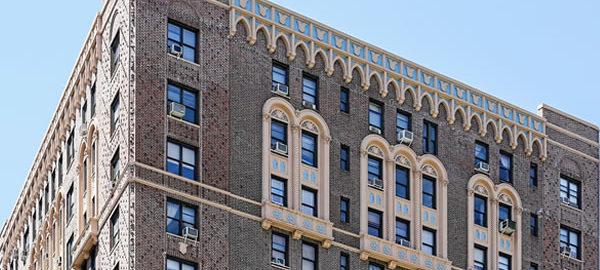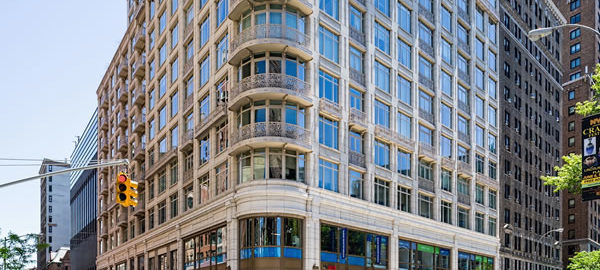New York at night is a light show: Exciting, dazzling, magical – beautiful close up or from afar.
These photos are available as prints (framed or unframed), posters and cards. Browse here.

New York at night is a light show: Exciting, dazzling, magical – beautiful close up or from afar.
These photos are available as prints (framed or unframed), posters and cards. Browse here.

Audubon Ballroom, built as a theater, played many roles during its century-long career. The colorful Broadway facade is all that is left of the original Audubon Theatre and Ballroom, aka Beverly Hills Theater, aka San Juan Theater.
Originally, the building contained a 2,500-seat theater and, on the second floor, a 200-guest ballroom. It was commissioned by William Fox (20th Century Fox) – which explains the terra cotta fox heads.
Audubon Ballroom was used for vaudeville and for motion pictures; later, union and political groups held meetings there. A congregation of German Jews held its services in the basement – and eventually bought the building in 1950. Malcolm X used the venue for meetings of his Organization of Afro-American Unity starting in 1964. It was here, on February 21, 1965, that Malcolm X was assassinated. In the 1960s and ’70s, the then-named San Juan Theater showcased Latino films.
New York City had taken possession of the building in 1967, for non-payment of taxes. After the San Juan Theater closed in 1980 the building began to deteriorate. In 1989 Columbia University made a deal with the city to demolish the building and build a medical research facility. Community activists, preservationists and even Columbia University students fought the plan, eventually winning a compromise that preserved a portion of the Broadway facade and the second-floor ballroom. Meanwhile, the Mary Woodard Lasker Biomedical Research Building rose six stories on the site of the former theater.
The lobby and second floor now houses the The Malcolm X & Dr. Betty Shabazz Memorial and Educational Center. A bank, a restaurant, a cafe, and a book store occupy other street-level spaces.

Church of St. Thomas the Apostle in Harlem is stunning architecture, even without its stained glass. Abandoned by the Catholic Church and once destined for demolition, the former church has found a new life as a community arts center.
The Archdiocese of New York closed the church in 2003 in the wake of declining attendance and ballooning maintenance costs. Although community groups sued to prevent demolition, the church transferred its German stained glass windows to Blessed Kateri Tekakwitha Church in LaGrangeville, NY in 2008. Meanwhile, the crumbling Harlem edifice was in limbo until 2012.
That’s when Artimus, a developer, purchased the church, its school and a nearby vacant lot from the Archdiocese of New York. The developer has since restored the front and rear walls and the ceiling. Additional restoration is continuing. Artimus is also converting the church’s school to affordable housing, and is to build a 10-story apartment house on a nearby vacant lot.

Williamsburgh Savings Bank is New York architecture that entertains from afar – and from close up. The tower’s graceful taper dominates the Brooklyn skyline for miles; the Rene Chambellan sculpture around the base fascinates passers-by. More sculpture, mosaics, and majestic vaulted ceilings overwhelm visitors inside.
The landmark fulfills architect Robert Helmer’s wish that the tower “be regarded as a cathedral dedicated to the furtherance of thrift and prosperity of the community it serves.” Not bad for a tiny bank that started out in the basement of a (now-demolished) church in 1851, before Williamsburgh dropped the “h” from its name.
Architects Halsey, McCormack & Helmer specialized in banks, so it is a little ironic that one of the firm’s non-bank buildings was the Central Methodist Episcopal Church – right next door to their “cathedral of thrift.”
The building is based on a steel “portal frame” – a special structure designed to support the weight of the massive tower above the equally massive void of the banking hall. (Think of this as a 35-story office building on top of a six-story church.) The bank insisted – over the architects’ objections – on a gilded dome as a crown for the tower. The dome was an architectural reference to Williamsburgh Savings Bank’s original headquarters in downtown Williamsburg.
When built, this was the tallest building in Brooklyn, and the clock was the largest four-sided clock tower in the world. “Brooklyn’s wristwatch” sometimes had trouble keeping time, but it seems to have been fixed. Although this was its headquarters, Williamsburgh Savings Bank only used two floors (above the banking level) as offices. The rest of the tower was rented – and for some reason, mostly to dentists!
Williamsburgh Savings Bank was acquired by Republic National Bank, and then merged into HSBC. In 2005, a partnership of the Dermot Company and Canyon-Johnson Urban Funds bought the tower. The lower floors were converted to Skylight One Hanson – event space – while the upper floors became 1 Hanson Place luxury condominiums.
The tower has the distinction of being triple-designated by the NYC Landmarks Preservation Commission: as an individual landmark (1977), as part of an historic district (1978), and as an interior landmark (1996).
Urban Omnibus has an exceptional narrative on the building’s history.

Riverside Memorial Chapel is suitably somber, suitably monumental for a funeral home. The structure is actually two buildings: The smaller 180 W 76th Street was given a new facade and joined to 331 Amsterdam Avenue in 1946.
The building underwent renovation and restoration in 1994-1998.

235 W 76th Street, aka The Colorado,* is a pre-war apartment building in Renaissance Revival style, enlivened by colorful terra cotta in the base and crown.
The building’s architect – Robert T. Lyons – is best known for his Beaux Arts masterpiece on Central Park West, the St. Urban.
* Not to be confused with the same-named Upper East Side condo.

334 Amsterdam Avenue, aka Samuel Priest Rose Building, is the home of the Jewish Community Center in Manhattan. The gray brick and blue glass cube is striking; its materials, style and colors stand out on an avenue dominated by earth-tone classic masonry structures.
The building’s recreational facilities – including a gymnasium and tenth-floor swimming pool – created unusual design challenges.
Architectural trivia: The center’s after-school activities include construction classes for budding architects! Dubbed “Crazy Constructions,” the program lets 6- and 7-year-olds “Design and build towers, bridges, houses, rollercoasters, and other superstructures. Join Dazzling Discoveries as you explore and experiment with plastic bricks, wood, paper, and many other materials. Students will learn about engineering, architecture, and physics while inventing and creating their own toys and projects.”

The Laureate is a modern condominium in a neighborhood dominated by landmark buildings almost a century older. The building is striking for its rounded corner, plentiful, ornate balconies, and sparkling white facades.

Beacon Hotel and Theater share a Broadway facade, but it’s the theater’s interior that keeps getting rave reviews. Conceived as part of the Roxy theater chain, the showplace was described by the Landmarks Preservation Commission (LPC) as “…a lavish space with stylistic effects drawn from the traditions of Greek, Roman, Renaissance, and Rococo architecture.”
The buildings are a collaboration of Samuel L. Rothafel – better known as Roxy – and The Chanin Construction Company. LPC explains, “Undoubtedly pleased with the success of combining three theaters with the Hotel Lincoln, thereby providing common building services for all, the Chanins saw a combination theater-hotel structure to be a logical solution for the site.”
Alas, Roxy’s plans did not pan out. Warner Bros. Pictures wound up with the theater lease. The Beacon continued as a movie theater until 1974, when the programs switched to live performances. The LPC designated the interior a landmark in 1979. In 1986 developers wanted to convert the Beacon to a disco – plans that were halted by a judge who said the conversion would irreparably harm the landmark’s architecture. Madison Square Garden Entertainment’s parent company, Cablevision, leased the Beacon in 2006. Cablevision restored the theater at a reported cost of $10 million. Madison Square Garden Company now manages the Beacon.
P.S. It’s called Beacon Hotel because of an airplane beacon on the roof.

West End Avenue – the stretch of 11th Avenue above W 59th Street – is one of New York’s architectural time capsules. The avenue boasts four historic districts, from W 70th Street to W 94th Street. The West End Preservation Society even argued that the entire avenue should be an historic district.
Personally, I find this half-mile section between W 76th and W 86th to be the most picturesque.
Odd-numbered buildings are on the west side of the avenue; even-numbered buildings are on the east side.